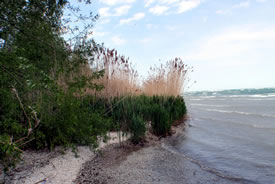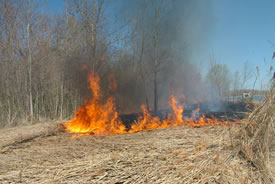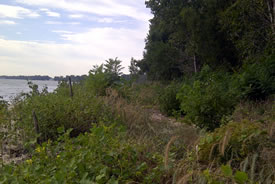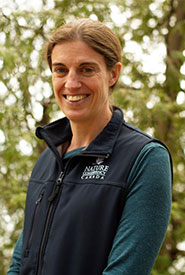Not wanted on the island: Combatting common reed on Pelee

Invasive non-native phragmites on Pelee Island (Photo by NCC)
No visit to beautiful Pelee Island is complete without a visit to the beach. The Nature Conservancy of Canada (NCC) has protected more than one kilometre of globally significant shoreline habitat on the island. This habitat supports turtles, snakes and rare plants, but is also a lovely place to take a walk and to watch the sunrise.
Unfortunately, until a few years ago more than 800 metres of this beach was dominated by the non native, invasive common reed (Phragmites australis). This very tall grass spreads via rhizomes across the ground and underground, and can rapidly colonise wetlands and damp habitats. It grows to two to six metres tall, and forms a colony that is impenetrable to people and wildlife alike.
Our beach was quite literally full of something that should not be there and had no wildlife value: common reed supports fewer insects than native beach and wetland plants, and therefore nesting birds find less food to feed their young. It can also be a death trap for turtles, which can push their way into the less dense outer edges of a common reed stand, then find themselves stuck in the dense, impenetrable inner areas.
So on one of our visits to the property Jill Crosthwaite and I carefully surveyed the common reed patch, looking for native plants and wildlife. This was very difficult, given the density of the stand. We found no plants or wildlife using the site. This finding fits with other work comparing common reed invaded areas with uninvaded areas. We knew we were safe to proceed with implementing the Ontario Ministry of Natural Resource’s Best Management Practices for Common Reed.

Pelee Island phragmite burn, ON (Photo by NCC)
We hired a contractor who very carefully in early spring rolled the dead material flat. We then waited for a calm, dry day, and burned the material. This removed many years worth of dead material and seeds. We then left the plants to grow throughout the summer. Although we had completely removed all of the above-ground biomass, most of the plant is actually underground. The root system of this species is far larger than the part of the plant that you can see!
Right at the end of the summer, deciduous plants such as common reed send their resources back to their root systems for winter storage. Just as the common reed was doing this, our contractor sprayed very diluted herbicide directly onto the leaves. The herbicide was absorbed and pulled down into the roots of the plant, killing it. The following spring, the only common reed to emerge was in the small areas that were not sprayed.

Habitat after burning, Pelee Island ON (Photo by NCC)
Jill and I have been monitoring the area ever since, conducting follow-up treatment on the remaining common reed and noting the plants that are colonising in its place. We were particularly excited to find a swamp rose mallow growing quite happily just two years after the common reed was removed.
Swamp rose mallow is Ontario’s only native hibiscus. It produces beautiful pink flowers, and we hope it expands to colonise the beach further.
More than 20 species of native plants have colonised the area, including evening primrose and Canada wild rye. This has provided us with a new seed source for these native plants, which we will use in our restoration work elsewhere on the island.
The beach is now easy to walk along, and visitors are welcome to enjoy the wildflowers, butterflies and birds that now thrive here.


